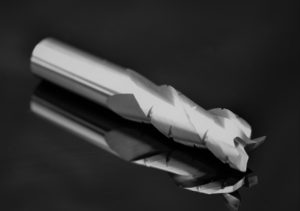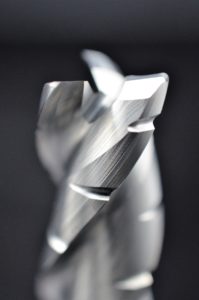Blog
Cutting Tool Breakage: The 3 Most Common Mistakes
Cutting tool breakage is a fact of life in this business. But you should be able to get your money’s worth out of them before it happens. There’s nothing like premature cutting tool breakage to get a machinist steamed. Not only is it slowing the operator down, it’s costing money. The problem is, there are a ton of variables that could be in play when a tool bites the dust before its time.
What’s to blame? Was it a bad tool? It’s not really like the old days when you could get a bad batch of carbide. It’s all reasonably good stuff today. So outside of that, what other reasons could be at fault for cutting tool breakage, chipping and inadequate performance? Let’s look at 3 of the more common mistakes.
ONE: Improper Tool Holder Assembly
In order to make good parts, run out and balance are fundamental. This leads to a discussion about whether you’ve chosen the correct type of toolholder for the application (collet chuck, end mill, hydraulic, milling and heat shrink types) the correct profile of the toolholder in regards to reach, and how far your tool is hanging out. The goal of course is to minimize runout and unbalance while gripping the tool adequately with maximum rigidity in the setup. These attributes become more or less significant depending on the application. For example, balance is more critical for high speed machining operations, while gripping torque is more crucial in roughing operations where pullout is more likely.

Correct Tool Holder: As a rule of thumb, we lean towards hydraulic chucks for hole making and maybe some light milling work; mill chucks for low speed milling and roughing. For high speed machining and/or high precision work, shrink fit tool holding.
Correct Length: More times than you might think, the selection of the toolholder is an afterthought. While many operators look to achieve short stick out lengths with the cutting tool, they often overlook the gage line of the holder itself. Marrying both the correct holder type with proper cutting tool stick out are both fundamental to optimum tool performance. Save the excessively long holders for only those applications that require the reach.
Stick Out Tip– For carbide tools, look to maintain an LDR (Length to Diameter Ratio) of 6:1 or less for optimum performance. When the applications require longer, you will need to reduce cutting parameters (speeds, feeds, depths of cut) to compensate for the increased tool deflection.
Correct Profile: The shape of the tool holder and construction has a lot to do with its inherent ability to provide rigidity or reach or balance in a given application over a long period of time. For example, mill chucks generally have greater centers of mass, that when coupled with internal needle bearings, create an extremely rigid holder that dampens vibration while achieving a high degree of gripping torque. However, the balance properties of these holders are often inconsistent, making them less ideal for long reach or finish operations. Slimmer profiles, like that of shrink fit holders, enable significantly more reach (hence shorter tool LDR) while possessing ideal balance and runout properties.
TWO: The Wrong Tool/Speed for the Material
When you call us with a tool life problem, probably the first things our technicians will ask is what material you are cutting followed by the speed, feed rate, radial and axial depth of cut.

If you’re running 303, 304 and 316L stainless steel, or Ti-6Al4V and other titanium alloys, you need a tool that can handle the excess heat generated at the contact edge. (See GWS Takes Aim at Gummy Materials for information about our PYSTL Series End Mills.)
A note about speed.What’s the first thing an operator does when a job doesn’t sound or look right? They turn the dial left and slow the machine down, right? It may seem counter-intuitive, but many of our tools are actually designed to run faster, not slower. This can be uncomfortable for operators who aren’t used to running at high speeds, especially if it’s a tool they are not familiar with. So, when we ask if you’re running at the right speed, we may mean you are not going fast enough to take advantage of the tool running in its sweet spot.
Machine tool and cutting tool technology have been leap-frogging for decades. A lot of operator habits developed back when cutting tools couldn’t match the total speed output of the CNC machine. Today, the learning curve has shifted back towards carbide tooling, where they are now fully capable of handling the speed and actually perform better at higher revs.
THREE: A Flawed Tool Path
Five to ten flute tools (and sometimes more) can be incredibly productive when properly applied. After all, more flutes equal greater feed rates. However, you have to marry it with the right type of tool path. While more flutes translate to higher feed rates, they also translate to less chip pocket space. Therefore, to be successful with these tools requires a specific tool path that keeps percentage of total tool engagement (relative to its diameter) limited, so as not to bury it and cause breakage. The amount of tool engagement varies, but generally the more flutes you have, the more careful you need to be to ensure its not overloaded (put into a slot or sharp corner). With the right tool path, techniques like full radial trochoidal milling tool paths can be used to shred cycle times!
We have had great success with our 7-flute tool cutting titanium, but we’ve also had people break it right away because it’s very dependent on the amount of engagement (as previously stated). It’s got to be consistently light. Slotting or heavy pocketing with a 7-flute tool is not going to work. It just doesn’t have enough chip clearance within each flute. With the right tool path that keeps cutter tool engagement at around 20 percent, the tool is going to run smoothly and permit optimum metal removal rates.
If tool engagement cannot be adjusted, using 4 or 5-flute end mills may be the optimum solution, as the large chip pockets provide more forgiveness in potentially unforgiving scenarios like pockets or deep slots.
A Lot to Think About
Of course, the simplest way to avoid premature cutting tool breakage is to call in the pros. Contact Us and we’ll be happy to conduct a thorough investigation of your particular application and help you optimize your process.
